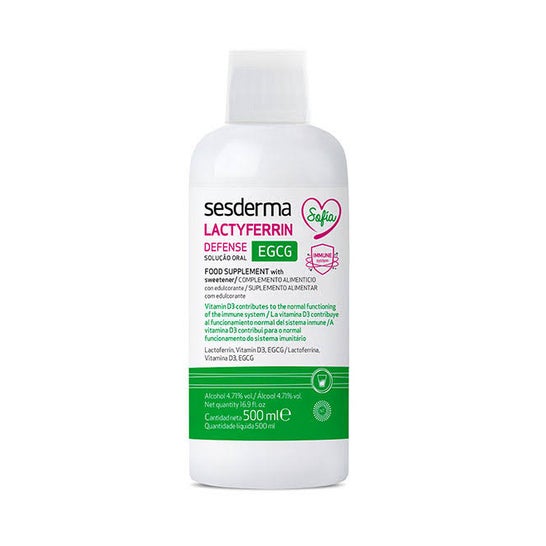Dietary supplement formulated with encapsulated lactoferrin and vitamin D3. Encapsulation in liposomes increases its effectiveness in the target cell, its tolerance and stability over time. It contains lactoferrin, a glycoprotein belonging to the transferrin family, which is found naturally in breast milk and in mammalian secretions (colostrum, saliva, tears, bronchial secretions, etc.). It also contains vitamin D3 which contributes to the normal functioning of the immune system and to the normal maintenance of bones.
Sesderma Lactyferrin Vitamin D3 500ml
Description
Instructions for use
It is recommended to take 3 times a week for a month and then two months off, unless otherwise recommended by a doctor.
Composition
WATER, STABILISER: (E-422) GLYCERIN; EMULSIFIER: (E-322) SOY LECITHIN, (E-432) POLYOXYETHYLENE SORBITAN MONOLAURATE; ALCOHOL, SWEETENER: (E-969) ADVANTAMO; MOCHA FLAVOURING, VITAMIN D3 100000 UI (CHOLECALCIFEROL), ANTIOXIDANT: (E-330) CITRIC ACID; BOVINE MILK LACTOFERRIN, PRESERVATIVES: (E-202) POTASSIUM SORBATE, (E-211) SODIUM BENZOATE; SWEETENER: (E-960) STEVIOL GLYCOSIDES 95%.
Pharmaceutical Advice
Vitamin D3 is produced in the dermis (deep layer of the skin) through the stimulation of UVB radiation. To a lesser extent, it can also be obtained through diet, with animal products such as oily fish.
It is known to play a regulatory role in bone maintenance (calcium and phosphorus content that form the skeleton), and on the immune and endocrine systems. Severe deficiency during childhood can lead to severe damage (rickets). This is why vitamin D supplementation is often given to infants, who should not be exposed to the sun during their first year, under paediatric supervision.
In adolescents and adults, moderate sun exposure (15 minutes per day) can cover vitamin D production needs. In the case of dark phototypes or certain diseases, these needs may not be sufficiently covered. To consider supplementation, it is advisable to consult a healthcare professional.
RELATED SEARCHES ABOUT Vitamins
New in Vitamins
- Zenement Multivitaminas Fresa 120 Gummies
- Drasanvi Multivitaminico Sport Live 90caps
- 226Ers Vitamin D3 4000Ui 120caps
- Dietmed Vitamineral Nutri 30caps
- Dietmed Vitamin D3 50ml
- Gse Veganplus Bio 60comp
- Gse Osteomin Bio 120comp
- Gse Zinc & Vitamin C Bio 60comp
- Gse Vitamin C Bio 60comp
- Gse Vitamin B12 Bio 120comp


